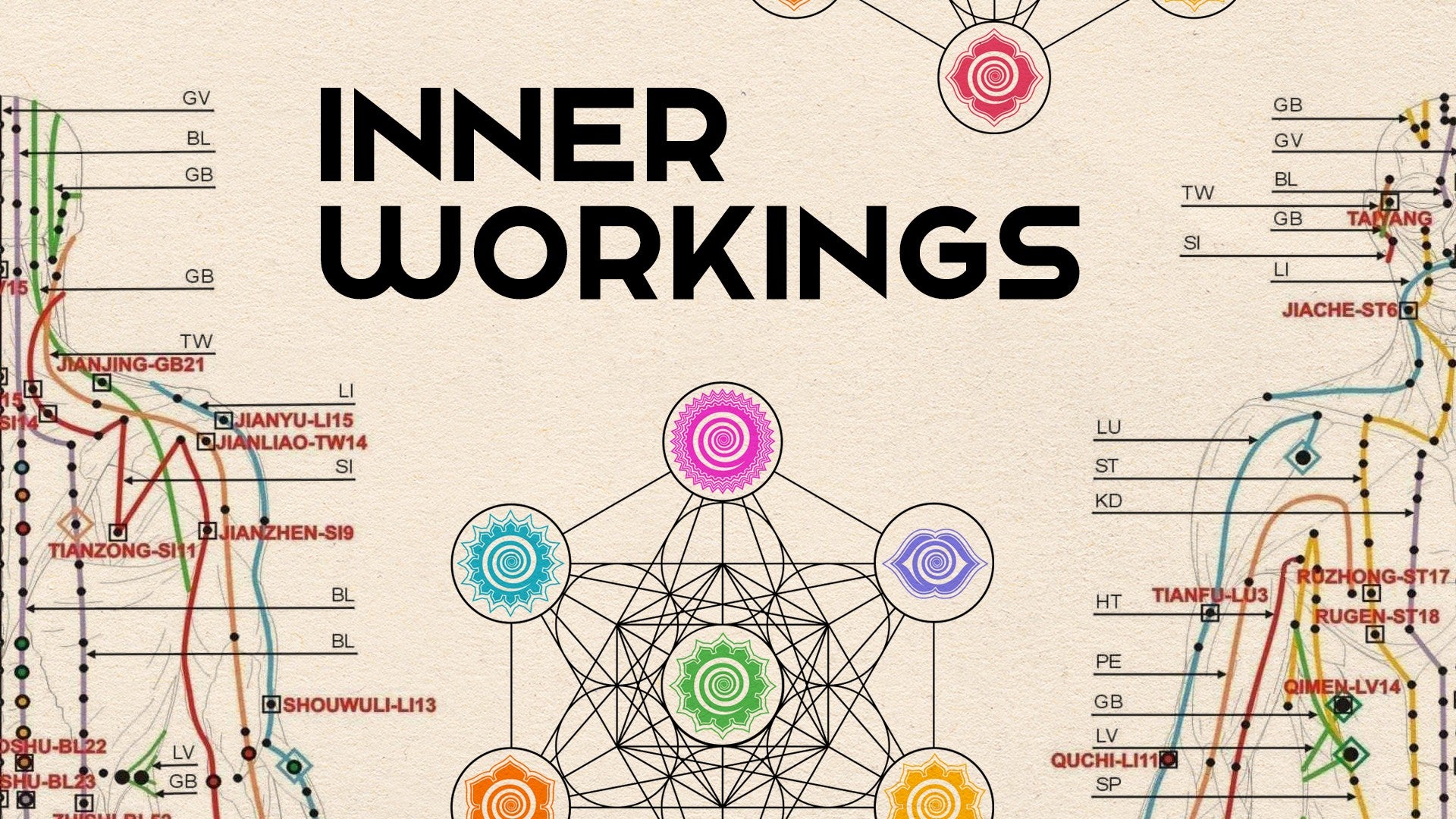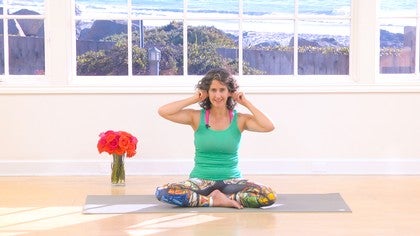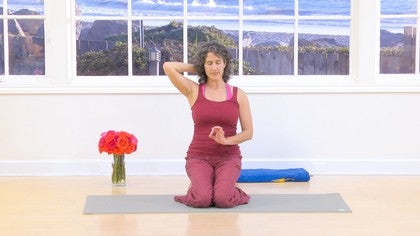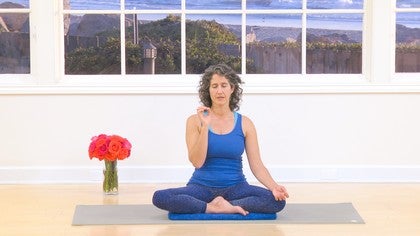Description
About This Video
Transcript
Read Full Transcript
(calming ocean waves) So we've come to the ears. And listening. And really one of the most important things is we engage in an effort to listen more deeply. It's so helpful to also start to study the temptation of not listening. Like why it's so difficult.
What benefits? What are we avoiding by not listening? Now the chakra of the ears are connected to is the throat chakra, the Vishuddhi. The root is said to sit in the C7 and the flower rumored to open, usually drawn to open in the center of the throat. I often feel more correspondence in this little tear drop of the throat.
Now the Vishuddhi which is said to govern communication, right? And so usually the Vishuddhi gets connected to the voice. Because most of us think about communication we think about talking. But, one mouth, two ears. An absolutely essential to communication is listening.
And so the play of this sequence, is to start to become more sensitive to our ears. And similar to what we've done in the mouth and the eyes, is become more sensitive to the tension we hold here. To the tightness, to the resistance. To allow this to open a little bit. And we'll do that by first we'll start out we'll just kind of engage with our ears a little bit, and meet our ears, start to get to know some of the anatomy of our ears.
Then we'll move into a black bee humming, Pranayama. Sometimes known as Bhramari. And then we'll move through a really simple sequence and in towards a seated meditation with an experiments in order to what we've been doing. So, thank you for being here. Step one, I'm in a comfortable seated position.
I'm on the floor, my heels aligned with each other and I'm siting upon a blanket. You might be in a chair. You might be on the floor. Big, deliberate inhale. Exhale let a (sigh) happen.
Soften the belly. And soften the pelvic floor. And relax. Let your heart find her natural, receptive generosity. Elbows are soft, shoulders are soft.
Good. And let your mind align. Nice. Nice. Okay.
Now tune into the quality of your palms that we've been tuning into. We really found it in our last episode with the heart. And let your hands feel more sensitive, more soft, more caring, more kind. So that as you begin to now bring them towards your ears. As you start to find between your thumb and your index knuckles you start to find your earlobe.
Can you let yourself touch your earlobe with the same sensitivity that you would a newborn? Can you actually let yourself feel the fuzziness oF your earlobe? And as you start to feel the fuzziness of your earlobe, you gotta really be sensitive here. You just, like slowly you'll start to tug here. And just tugging so gently, just like a little bit.
One side and then the other. And on one side and then the other. And just start to make your way up that, up the outer ridges of the ear, the auricle. So the outer ear's name is the auricle. And I just find that if I'm move from side to side I'm more sensitive in what's happening.
Doo, doo, doo. Trust me on this one. Now you're going to get up to that point where if you were a cousin of Spock, might be little pointies, just kind of pull in here a little bit. And then kind of in from there a little bit. And now as you make your way back down little bit more instead of just gentle tugs from side to side, can you find that spot?
Can you kind of hold on to your ears and just like pull and the hand will like start to kind of slide almost off. And then you start to pull the other one. Then you find a new ear hole, then you pull, kind of like it slides off. I mean I guess if your ears were super dry that wouldn't work, but most of us have enough grease between our ear and our hand that it just sort of works. Slide off, now you're making your way back down to the earlobe.
And as you make your way back down to the earlobe once you find the earlobe, just gently begin to tug down. Now in so many images of the Buddha, you know, sacred art is there to make the invisible visible. So many images of the Buddha they have these giant ears. It's a sign of wisdom. Good.
Okay, eventually you'll be done with that. The hands will come off, let the hands rest. And then just close your eyes, big, deliberate inhale. Exhale everything, and allow your ears to feel open and warm. Start to tune into the auricle.
So the auricles right, these beautiful outer ears these are designed to bring the vibrations, in, all these beautiful ridges and bumps. This is, these are all designed to help funnel the vibrations. Nice. So let's just get a little bit more sense kind of tuning to the ear, we're going to make our way to the black bee buzzing. Bhramari Pranayama.
And I'm really excited to share this. Because it's a wonderful practice. And I have to be willing to look like such an excellent fool to share it. Okay so big, deliberate inhale. Exhale everything.
Close your eyes, close your mouth. And we're going to take this breath in three stages. Stage one is just starting to be able to make the sound of the bumblebee, which today is something like. (low humming) So try that, eyes closed, mouth closed. Inhale.
And as you exhale. (low humming) Nice. Now the second step, is we're going to close off our ears and do the same thing. So I like to use my thumbs for this. Now you got these little ear flaps.
So one way to do it is to just use your thumbs up against the ear flaps. And kind of close off your ears. Okay but, that's one way, but I find it much more comfortable as long it's not too gross in there to just sort of stick your thumbs in there. So either just stick your thumbs in there or close off the ear flaps. And we'll make the bumblebee sound again.
So as you're ready, nozzle in the ears, either thumbs in or flaps. Inhale, and as you're ready. (low humming) Keep your ears closed. Keep your eyes closed, do that again, inhale. (low humming) Super nice.
Now the third step, the third part, is you keep your thumbs in your ears either flaps closing or (clicks tongue) stuck in there. And you're going to bring your second and your third finger to lightly rest on your eyelids. Okay so it's thumbs in ears. Second and third finger, lightly on your eyelids. And then we do that again.
So, second and third fingers on your eyelids. Thumbs in your ear. Deep breath, inhale. (low humming) Two more times. (low humming) One more time.
(low humming) Eventually it'll feel correct to release the hands. Down onto your legs. And then just pause and feel the effect. Soften the jaw. And now really start to tune just like we've been doing with the sense organs.
Start to tune to your left ear. And really start to let your left ear open. So like for real feel the auricle get bigger. Softer. Feel the area around the ear relax.
Soften the jaw. And what's occurring right, like is the auricle brings in the sound waves they're coming down towards the eardrum, or tympanic membrane. Where they're being translated into vibrations we can understand better with those three little bones, the hammer, the anvil, and the stirrup. That are taking all of these sound waves, translating them into a different bee. Increasing their pressure.
And those get translated in the inner ear into awe and transferred to the auditory nerve. And then we interpret what we're hearing. So the translation is happening right here. Okay so soften the left ear. You might feel it down through the throat.
The ears and the throat are intimately connected. So sometimes you feel that eustachian tube open. And so now same idea on the other side. So feel your right ear open, like feel the auricle widen. Good.
Feel all around the ears soften. And can you use your imaginal realm to just kind of go in deeper, like can you have a sense of where your eardrum is? Can you imagine those three little bones? Soften the jaw, let the throat ease. Good.
Super nice. Let both ears feel open. And so the play as we make our way into just a super simple, seated sequence like we've been doing. The play is can we allow our ears to stay open? And can we actually start to listen to the body?
So I'm going to start in box pose. If box pose with some of you in colder climates know as fire log, or double pigeon, it doesn't really work for you. Pigeon or cow face would also work. One ankle is on top of one knee. Other knee is on top of other ankle.
And the play here for me, the request, okay is whatever hip you have started with on top. Let the corresponding ear open. So as opposed to focusing so much on the hip, can you allow the ear to open? And can you start to find out how to listen to the hip? Okay now listening is almost impossible when you're talking.
And so if you've all sorts of things to say to the hip, you're not really listening. And like open. Good. And for some of you this might be the perfect spot. But what some of you are naturally going to do is you're going to want to lean in a little bit.
And as you lean in a little bit the weight of your arms will help deepen the possibility, but if you get caught in the mouth, or the jaw, or the eyes, then you're no longer listening. It's like (sigh) listen. And the play here is that sometimes, like the few of us are lucky enough to have had the rare occurrence of actually being listened to. And, what seems to happen when somebody's really listening, is there's no longer anything to say. It's like the communication is happening on this deeper level.
So the play here is, as we listen to the hip does she give up a little bit her song of complaint? Okay so for most of you right here is the way to go. Couple of you are put together in such a way that coming a little bit more forward might feel good. Like, I like to let my elbows bend and as we've been exploring this palm open situation like, helps so much. Okay, back of the neck is wide, gooey in the face.
Few more beats. Then slow, chin into the chest. Let yourself roll all the way back up. Nice. Lean back, switch the cross of the legs.
So bring the opposite leg on top. And usually again, the suggestion of the shape is that one ankle is above one knee, one knee is above one ankle and you know if it's feeling more like envelope than box pose, that might be effective. But you might choose something like pigeon. Again, box is what we call it down here in Southern California usually. Because fire log doesn't have much relevance for us.
Let a little bit of a (sighs) happen. And again as you come into that hip, tune the side of the ear of the hip that you're playing with. So let the ear open, soften, the area around the ear, soften the jaw. Auricle, let the auricle widen. And then we've been practicing so much you can let that eye soften.
So again, some of you, right here is going to be the spot. Some of you a little bit of weight on those legs might feel nice. It's like (sighs). You'll know, like we know when we're forcing, because it feels like force. It's really this simple.
And this way might be different. So you might have come forward on the other side but this side, it might not be appropriate. Okay, so it might be right to stay here, if it's useful to come forward, you can come forward. Again, you might have a different method. I like to let my elbows bend, my palms turn up.
More of a sense of offering. Receptivity, listening. But, and I'm finding that it just seems like it would feel nice to bring my ring finger in, and find my thumb up against that inner little spot. Listen. Nice.
Beautiful, okay, chin into the chest. Let yourself roll all the way back up. Super nice, so we'll make our way into one of my favorite shapes for a little bit of variation. So bring your left foot out. Now as we make our way to revolving head to knee pose, most of you know it with the sole of the foot on the inner thigh, and if you prefer this method.
(clicks tongue) No problem. But if it would feel good, maybe try this. So my right foot is in more of almost like a squat position. And then here is where it starts to get super fun. I'm going to bring my left hand to my right ankle.
Now the play here is I'm letting this hip roll open and away from me. So there's a little bit of a dynamic tension. I'm holding the ankle as this hip is rolling away from me. I'm tuning that right ear and I'm listening. Little flex for this foot.
And then eventually I'm starting to kind of like pull that hip away as I hold onto the knee. And I'm leaning over. I'm tuning this top ear. And this might feel good for some of you. You might get a little lower.
So this might be the spot for some of you. Some of are you going to going to start to reach this arm up, out and over. Sometimes it feels good to reach. Sometimes it feels good to round a little bit. Sometimes it feels good to roll open a little bit.
If you have the limb torso relationship that lets you grab that foot you might. So that if I roll this right hip away then I can get this super nice line through here. Let the ear open. Listen. Nice.
When you feel cooked take a look down, let yourself come all the way back up. And pause. Lean back. Free this leg. Bend the other leg.
Schnuggle in. Catch a hold of that ankle, so, I'm letting my right hand find that left ankle. Root. And then you're rolling this hip away from you. So you're rolling this hip away from you.
So she's providing the support as you start to lean in. So she's providing the support as you start to lean in. This hand usually likes to kind of assist. Now just depending on how you're designed, it's just likely that this foot will turn out a little bit. If you feel like being a stickler.
You could keep it straight up but that's up to you. Listen. Circle this arm over. And like reach so you've got this, it's all about the play of the leverage. So, I'm more kind of root and roll this open.
The more I can reach through this arm. And the different fingers will help you. Listen. Like let this help open up through the ear. So some of you might, the reach might feel better, the foot might be easily available.
That just has a lot to do with the limb torso relationship. I'm finding that I actually want to organize this arm a little lower. Couple more moments and even though grabbing the foot is nice because it allows for more rotation. And lose out on the stretch. So, compromises.
Eventually look down, inhale, bring you all the way back up. Pause. Nice. Let's find our way into baddha konasana. So I like to have the soles of the feet together about a foot and a half, that's not even true at all.
Today's about six inches, six to eight inches away from the groin. I'm going to move this blanket out of the way. Hands are going to come behind me. I like to turn my fingertips back today for some reason. Sometimes it's nice to turn them forward but today it's back.
Roll the shoulders back and down. Wobble up. I'm going to wobble and roll the hips forward. Letting that heart open and pause before you go two feet, let your ears open. Right here might be the spot.
Some of you are going to let your throat start to open and as we've already played with some of you are going to root. You're going to lift up through the hips, you're going to let your chest lift. And you're going to wobble back. Nice. And then eventually the hips are going to come back down and you're going to let your heart lift.
And come all the way up. Sweet. Find a comfortable spot for our meditation experiment. Again, maybe you're finding your electric blue blanket like me. Sit up on there.
Big, deliberate inhale. Exhale everything. And sometimes we think this is about listening to other people. But in the practices of pratyahara, and the tuning of the senses inward, what we start to become aware of is actually us we're listening to. All the time.
And so the play of that is to notice, what happens when we're actually listening and just to be a little bit, just to like (shushes) Unpack that a little bit more. It's us we're hearing all the time. But whether or not we're actually listening is a different thing. So in this meditation experiment like the others, the softening of the ears is our reference point. Okay?
Big, deliberate inhale. Exhale everything, let a (sigh) happen and soften. Soften the floor of the pelvis, soften the low belly. Feel the natural generosity of the heart. Feel the shoulders easy.
Feel the mind light. Turn your palms so they're soft and open. And now again, let one ear, let your left ear open first, it's just easier to do one side and then the other. Widen the auricle, soft around the temples. Jaw soft, throat soft.
And then let your right ear open. Yeah. And be so sensitive to the openness of your ears. And now so gently and in the interests of yogi science, so gently. Begin to let your mind turn towards one of your favorite, let's use the time like negative self talks.
Like one of your favorite kind of, stories that you hear yourself communicating. If what I'm saying doesn't make sense just maybe one of your favorite worries. Just start to play one of your favorite, latest worries. And just hear this in your head and as you start to hear this, as you start to play this story, play this tone, can you become aware of now what your ears have done? And maybe, maybe, maybe not, your own data is more important than what I might suggest might be happening, but, maybe the ears have become closed.
Relax, big, deliberate inhale. Exhale everything, soften the jaw a little bit. And so in the second round of this experiment, and so you know we're in this together, so if the direction of this experiment, if the results you got are different than what I'm suggesting might have happened then we really want to know. So in the second part of this experiment, what we'll do is we'll sit, we'll open the ears again and we'll bring in the favorite latest worry. If you're not sure what I mean by self talk it's that, negative self talk, it's that cycle that can happen so quickly, like one little thing gets quote unquote messed up, right?
Like you forgot to water, you know, you forgot to turn off the water. And in Southern California that is a big deal. Okay, you forgot to turn off the water, just a simple, simple, simple mistake, but suddenly you forgot to turn off the water turns into I'm a loser, I'm no good, I have no friends, and I'm fat. It's like (raspberry noise) Alright, that's what I do, I'm just like (buzzing) Like where are you going to end up at? Or maybe it's just a favorite latest worry that you have, okay?
Pretty sure you have at least one. Then we'll go in there, we'll open up the ears, we'll find that, you know, that negative self talk or that favorite latest worry. And then we'll do our best to let the worrier or the talk be there but instead of focusing on it we'll focus again on opening up the ears, so that we're really listening. Okay, let's try. Big, deliberate inhale.
Exhale everything. Let a (sigh) happen, soften the belly, soften the floor of the pelvis. Heart is generous and easy. Mind is light. And step one, let your ears open.
Now again, maybe you've gotten a sense of how to do both at the same time but most of us it works better to find one side. And then the other. And there's usually a corresponding ease in the throat. Wideness at the base of the skull. Now only as you're ready, just like let that favorite latest worry come in or, favorite negative talk and, the play here is like, hear the worry or hear the usual story.
And now, again, start to relax the tension of the ears. And as you relax the tension of the ears, as you feel the auricles wide, the earlobes soft, the eardrums like, open. The inner ear fluid. As you tune to the sensitivity, is there a shift? Is there any change?
With you and what you were just, the tune you were just playing. Okay, last few moments. Nice. Beautiful, relax the project, rest here. Eyes closed, ears open, palms available.
Sit here for as long as feels correct. Thank you for your practice, your willingness to experiment. Namaste.
Inner Workings: Sensing the Self
Comments
You need to be a subscriber to post a comment.
Please Log In or Create an Account to start your free trial.











